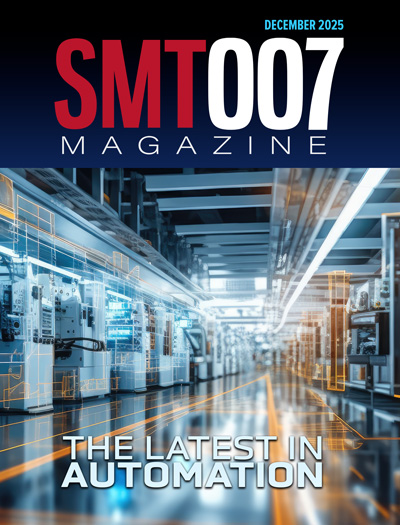-

- News
- Books
Featured Books
- smt007 Magazine
Latest Issues
Current Issue
The Latest in Automation
When customer requirements shift, responses range from new equipment to automation. Explore the newest solutions reshaping production and how today’s market dynamics are driving these trends.

Spotlight on Mexico
Mexico isn’t just part of the electronics manufacturing conversation—it’s leading it. From growing investments to cross-border collaborations, Mexico is fast becoming the center of electronics in North America. This issue includes bilingual content, with all feature articles available in both English and Spanish.

Production Software Integration
EMS companies need advanced software systems to thrive and compete. But these systems require significant effort to integrate and deploy. What is the reality, and how can we make it easier for everyone?
- Articles
- Columns
- Links
- Media kit
||| MENU - smt007 Magazine
Untapped Potential: Automating Warehouse Management Into the Present
October 15, 2024 | Josh Casper, Horizon SalesEstimated reading time: 2 minutes
The push toward automation in electronics manufacturing has led to significant improvements in SMT and through-hole technology (THT) production. Today’s manufacturers are outfitted with precision pick-and-place machines, sophisticated inspection systems, and advanced solder deposition solutions. These investments reflect a broader industry trend toward automating high-value production tasks to boost efficiency, improve quality, and reduce headcount in a shrinking labor market. While the spotlight has rightly focused on automating SMT production, one crucial area remains woefully under-invested: materials storage and handling.
This oversight is particularly concerning given the critical role that materials management plays in the overall manufacturing process. Materials—such as SMT/THT components, bare boards, and solder paste—are the lifeblood of production. How they are stored, tracked, and deployed directly impacts the effectiveness of the entire operation. Here, we’ll explore the impact of material handling and how automating this area can significantly enhance productivity, reduce costs, and ensure quality in electronics manufacturing.
The Impact of Manual Materials Handling
Manual materials handling remains a significant bottleneck in many electronics manufacturing facilities. In traditional setups, components are stored on shelves or in bins, with warehouse employees responsible for manually retrieving and deploying them to the production line. This manual process leads to myriad issues.
First, manual component kitting is one of the more labor-intensive areas of the facility. Operators are tasked with manually moving from location to location and retrieving one part at a time. For argument’s sake, if an operator can pick a single part every minute (and that’s being very aggressive), a smaller 60-piece kit would take at least an hour to pick. Now, multiply that across all the jobs and a manufacturer could be pulling in a single eight-hour shift. How many employees are dedicated to just pulling and returning materials? The time spent locating and moving materials slows down the production process, significantly negating the benefits of advanced automation on the SMT line.
Another common issue in manual picking is component misplacement. When reels are stored on shelves and tied to a manual location, it is entirely dependent upon the operator to ensure they’re not only pulling the correct part, but also returning it to the correct location. It’s human nature to make these mistakes, but they can easily compound, leading to line stoppages due to a single missing component. Worse yet, having the automated placement equipment placing the wrong component on multiple PCBs creates re-work havoc because it was incorrectly put in a kit by the manual picking operation.
Manual handling often leads to inventory inaccuracies as well. Without real-time tracking and automated management, it’s easy for inventory levels to become misaligned with actual stock. This can result in overstocking, which ties up valuable space and capital, or stock outages, which can halt production and lead to costly emergency ordering. Component visibility is critical, especially in a world where component availability leaves much to be desired.
To read the rest of this article, which appeared in the October 2024 issue of SMT007 Magazine, click here.
Testimonial
"In a year when every marketing dollar mattered, I chose to keep I-Connect007 in our 2025 plan. Their commitment to high-quality, insightful content aligns with Koh Young’s values and helps readers navigate a changing industry. "
Brent Fischthal - Koh YoungSuggested Items
Fresh PCB Concepts: Quick-turn Prototype PCB Fabrication to Production Volume
11/20/2025 | Team NCAB -- Column: Fresh PCB ConceptsFor a PCB engineer, the path from prototype to production is a careful balance of speed, precision, and foresight. Quick-turn prototype fabrication focuses on speed and design validation, while production builds demand repeatability, cost control, and quality assurance at scale.
Tesla Weighs Building ‘Gigantic’ Chip Fab to Meet AI Demand
11/17/2025 | I-Connect007 Editorial TeamTesla CEO Elon Musk said the company will probably need to build a “gigantic” semiconductor fabrication plant to support its expanding artificial intelligence and robotics plans, CNBC reported.
India Approves $626 Million in Projects to Boost Electronics Parts Output
11/11/2025 | I-Connect007India’s government approved seven projects on Oct. 27, totaling over 55 billion rupees ($626 million), that will expand the domestic production of electronic parts, Reuters reported.
Real Time with... SMTAI 2025: Navigating Manufacturing Challenges with Akrometrix
11/03/2025 | Real Time with...SMTAIMarcy LaRont and Paul Handler of Aktrometrix share insights from the SMTAI show in Chicago. They address manufacturing challenges, particularly warpage issues, and discuss Akrometrix's solutions. Paul details three optical technologies for measuring warpage and thermal expansion, emphasizing the need for reliability and defect detection in production. The conversation also touches on new industry standards for board warpage, influenced by OEMs.
Unlocking the Promise of AI in Electronics Manufacturing
10/29/2025 | Shobhit Agrawal, Keysight TechnologiesThe electronics manufacturing industry is rapidly evolving as more complicated products are introduced in the production lines, which require technological advancements even in the production processes. The requirements for production that is efficient, product quality that is greater, and product life cycles that are shorter are more crucial than ever before. In the electronic device life cycle, from design to maintenance, test phases have a significant impact on the economy of the company. Test processes are closely linked to the production volume and impacted by the complexity of the product. For businesses to maintain their competitive edge, they need to adopt innovative solutions and redefine processes.


